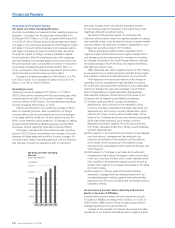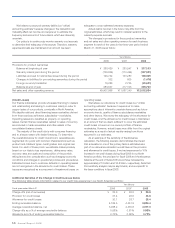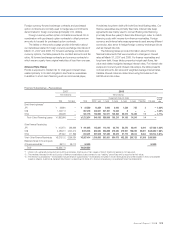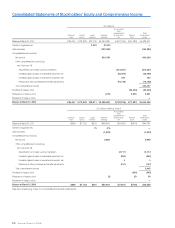Honda 2008 Annual Report Download - page 58
Download and view the complete annual report
Please find page 58 of the 2008 Honda annual report below. You can navigate through the pages in the report by either clicking on the pages listed below, or by using the keyword search tool below to find specific information within the annual report.
A n n u a l R e p o r t 2 0 0 8
5 6
We believe our accrued warranty liability is a “critical
accounting estimate” because changes in the calculation can
materially affect net income, and require us to estimate the
frequency and amounts of future claims, which are inherently
uncertain.
Our policy is to continuously monitor warranty cost accruals
to determine their adequacy of the accrual. Therefore, warranty
expense accruals are maintained at an amount we deem
adequate to cover estimated warranty expenses.
Actual claims incurred in the future may differ from the
original estimates, which may result in material revisions to the
warranty expense accruals.
The changes in provisions for those product warranties
and net sales and other operating revenue for each business
segment for each of the years in the three-year period ended
March 31, 2008 are as follow:
Yen (millions)
2006 2007 2008
Provisions for product warranties
Balance at beginning of year ¥ 268,429 ¥ 283,947 ¥ 317,103
Warranty claims paid during the period (126,834) (113,454) (137,591)
Liabilities accrued for warranties issued during the period 125,732 143,280 136,355
Changes in liabilities for pre-existing warranties during the period 332 605 (1,476)
Foreign currency translation 16,288 2,725 (20,631)
Balance at end of year 283,947 317,103 293,760
Net sales and other operating revenue ¥9,907,996 ¥11,087,140 ¥12,002,834
(Credit Losses)
Our finance subsidiaries provide wholesale financing to dealers
and retail lending and leasing to customers mainly in order to
support sales of our products, principally in North America.
We classify retail and direct financing lease receivables derived
from those services as finance subsidiaries—receivables.
Operating leases are classified as property on operating
leases. Certain finance receivables related to sales of inventory
are included in trade receivables and other assets in the
consolidated balance sheets.
The majority of the credit risk is with consumer financing
and to a lesser extent with dealer financing. To determine
the overall allowance for credit loss amount, receivables are
segmented into pools with common characteristics such as
product and collateral types, credit grades, and original loan
terms. For each of these pools, we estimate losses primarily
based on our historic loss experiences, delinquency rates,
recovery rates and scale and composition of the portfolio,
taking factors into consideration such as changing economic
conditions and changes in operational policies and procedures.
Estimated losses due to customer defaults on operating leases
are not recognized in the allowance for credit losses. These
losses are recognized as a component of impairment losses on
operating leases.
We believe our allowance for credit losses is a “critical
accounting estimate” because it requires us to make
assumptions about inherently uncertain items such as future
economic trends, quality of finance subsidiaries receivables
and other factors. We review the adequacy of the allowance for
credit losses, and the allowance for credit losses is maintained
at an amount that we deem sufficient to cover the estimated
credit losses incurred on our owned portfolio of finance
receivables. However, actual losses may differ from the original
estimates as a result of actual results varying from those
assumed in our estimates.
As an example of the sensitivity of the allowance
calculation, the following scenario demonstrates the impact
that a deviation in one of the primary factors estimated as a
part of our allowance calculation would have on the provision
and allowance for credit losses. If we had experienced a 10%
increase in net credit losses during fiscal 2008 in our North
America portfolio, the provision for fiscal 2008 and the allowance
balance at the end of fiscal 2008 would have increased by
approximately ¥7.2 billion and ¥2.8 billion, respectively. Note that
this sensitivity analysis may be asymmetric, and are specific to
the base conditions in fiscal 2008.
Additional Narrative of the Change in Credit Loss as Below
The following table shows information related to our credit loss experience in our North American portfolio:
Yen (billions)
Fiscal years ended March 31 2006 2007 2008
Charge-offs (net of recoveries) ¥ 22.8 ¥ 26.2 ¥ 39.9
Provision for credit losses 27.4 25.5 44.8
Allowance for credit losses 30.1 28.7 28.4
Ending receivable balance 4,166.5 4,351.8 3,890.4
Average receivable balance, net 3,938.2 4,330.8 4,317.0
Charge-offs as a % of average receivable balance 0.58% 0.61% 0.93%
Allowance as a % of ending receivable balance 0.72% 0.66% 0.73%
























